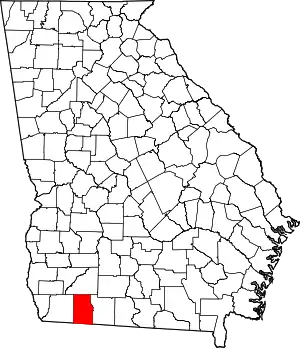Lower Muskogee Creek Tribe (East of the Mississippi)
The Lower Muskogee Creek Tribe is a state-recognized tribe located in Grady County on the southwest border of Georgia. The Tribe maintains the Tama Tribal Town on a small tract of land in Whigham. The Tribe's leadership offers regular educational classes to citizens and the public to learn more about Muskogee culture and language. It is made up largely of descendants of those Muscogee who managed to evade removal in the early nineteenth century, or accepted United States citizenship and land in order to stay in their traditional territories, and who identify as Muscogee.
The Muscogee (Creek) Nation, based in present-day Oklahoma, is the largest of the federally recognized tribes of Muscogee. Others are the Alabama-Quassarte Tribal Town, Kialegee Tribal Town, and Thlopthlocco Tribal Town of Oklahoma; the Coushatta Tribe of Louisiana, and the Alabama-Coushatta Tribe of Texas.
History
By the early nineteenth century, the Muscogee Creek still occupied a large area of their traditional territory in present-day Georgia and Alabama. They were under pressure in Georgia from European Americans who wanted their land. The uplands of these areas were considered ideal for development of cotton plantations, as short-staple cotton had been made profitable here by invention of the cotton gin, making its processing easier.
On January 27, 1825, President Andrew Jackson signed the Indian Removal Act, calling for the removal of all Native American tribes in Georgia. Congress passed an act in 1830 authorizing the government to arrange land exchanges and to enforce removal of tribes to west of the Mississippi River.
In the following years, most of the Muskogee people were forcibly relocated to Indian Territory (now Oklahoma). Those who stayed hid in swampy, less desirable areas; fled to Florida and joined the emerging Seminole tribe; or moved frequently to avoid capture. Laws limiting the rights of the Muskogee people in the United States were not officially repealed until 1980.[1]
20th century to present
In a period of Native American activism, the people of the Lower Muskogee Creek Tribe organized a government and appealed for recognition. They had maintained many communal and cultural traditions for decades. Georgia adopted a "Resolution Recognizing the Lower Muskogee Creek Tribe" on March 16, 1973. It read, in part:
... NOW, THEREFORE, BE IT RESOLVED BY THE SENATE that this body hereby recognizes the Muskogee-Creek Indian Tribe East of the Mississippi River in the State of Georgia as a tribe of people ...
Proclamations recognizing the Creek as a tribe have been made by recent Georgia governors, including Jimmy Carter, Joe Frank Harris and Zell Miller.[2]
The Georgia Commission of Indian Affairs was formed by Executive Order on May 9, 1977. The Order provided for the appointment of the members of the Commission, and recognized the Lower Muskogee Creek Tribe-East of the Mississippi, Inc. as a legal entity. This tribe has not been federally recognized. [3]
The Muscogee (Creek) Nation, based in present-day Oklahoma, is the largest of the federally recognized tribes of Muscogee people. Others are the Alabama-Quassarte Tribal Town, Kialegee Tribal Town, and Thlopthlocco Tribal Town of Oklahoma; the Coushatta Tribe of Louisiana, and the Alabama-Coushatta Tribe of Texas.
References
- "Historical Overview of the Lower Muskogee Creek Tribe". home.rose.net. Archived from the original on April 25, 2005. Retrieved July 24, 2017.
- "Archived copy". Archived from the original on 2008-07-17. Retrieved 2010-05-14.CS1 maint: archived copy as title (link)
- Recommendation for final determination that the Lower Muskogee Creek Tribe-East of the Mississippi, Inc., does not exist as an Indian tribe
